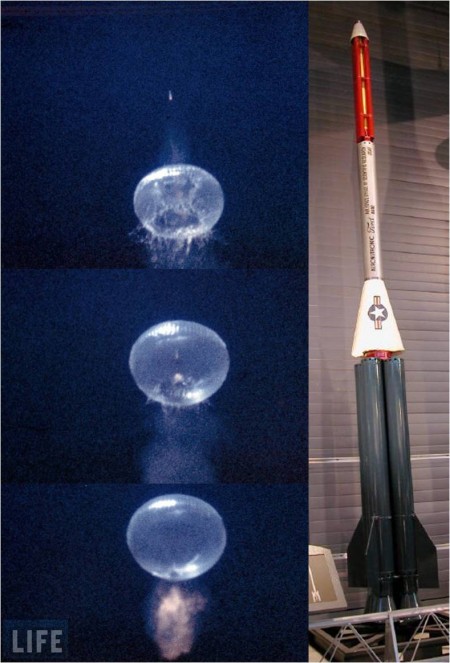Fifty-five years ago this month, the final test shot in the Operation Farside test series took place near Eniwetok Atoll in the Marshall Islands. The final stage of the 4-stage research rocket reached a top speed close to 18,000 mph.
Operation Farside was a USAF Office of Scientific Research project intended to probe the space environment to altitudes as high as 3,400 nm. The approach taken for doing so involved launching a 4-stage rocket from a balloon floating at an altitude of 100,000 feet. Firing the rocket from this height significantly reduced the vehicle’s aerodynamic drag and allowed it to fly much higher than if launch had occurred at sea level.
The 4-stage Farside rocket measured 24 feet in length and had a maximum diameter of 1.5 feet. Firing weight of the Aeronutronics-developed vehicle was 1,900 lbs. Stages 1 and 2 utilized fins for providing static stability while Stage 3 and 4 were spin-stabilized. Each of these stages employed solid rocket propulsion.
The Farside payload weighed a mere 4 lbs. Its job was to measure the cosmic ray, electromagnetic radiation, space gas, and space dust environments and transmit the data back to Earth.
The Farside rocket was carried to launch altitude by a 3.75-million cubic foot, helium-filled, polyethelene film balloon. The vehicle was cradled within an aluminum lattice-work launch tower suspended directly below the balloon. Upon ignition of the first stage rocket motor, the Farside rocket fired right through the middle of its carrier balloon.
There were six (6) shots in the Operation Fireside test series. The first vehicle was launched on Wednesday, 25 September 1957. However, the mission failed when the carrier balloon malfunctioned. The remaining five (5) test rounds were fired in October of 1957. Unfortunately, the next three (3) flights suffered ignition failures in one or more stages.
Operation Farside finally enjoyed some success with Test Shot 5, flown on Sunday, 20 October 1957. While all of the stages functioned as planned, the probe’s telemetry system failed to transmit any scientific data back to the ground. The inoperative transmitter resulted in degraded tracking, with the result that the apogee altitude of the round was never known with accuracy.
The sixth and final Operation Farside test shot occurred on Tuesday, 22 October 1957. Ironically, the results of this flight were essentially the same as Test Shot 5. All of the stages fired, but telemetry system failure once again resulted in loss of mission environmental and performance data. At this point, Operation Farside was fresh out of balloons and rocket vehicles. And with that, the program was officially over.
The United States Air Force had hoped to follow Operation Farside with a more ambitious program to fly a 5-stage, rocket-powered vehicle within shouting distance of the moon. A review of the historical record reveals that such a program was never in fact pursued.

